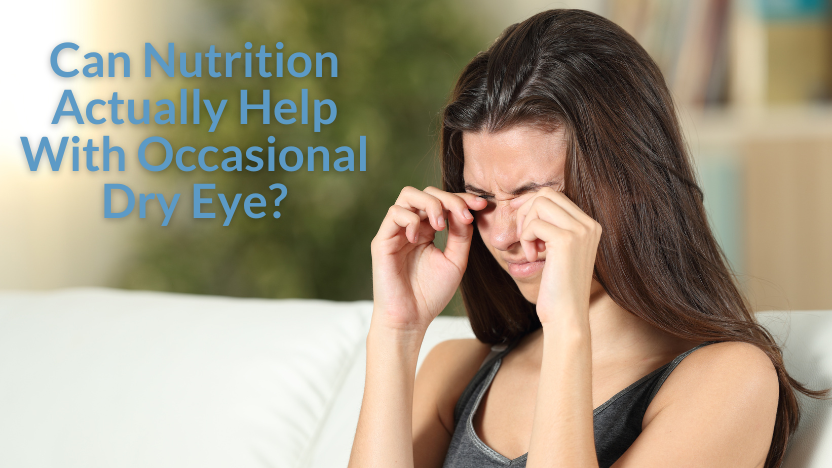Busting Myths About Nutrition and Occasional Dry Eye
Posted by EyePromise on Aug 17th 2023
Occasional dry eye affects millions of Americans, many of whom don’t even realize they have it. Solutions range from eye drops to warm compresses to lid cleaners to nutraceuticals. However, more and more practitioners are starting to question the validity of nutritional intervention, despite the DEWS II report explicitly adding nutraceuticals to its Stage 1 protocols. Drs. Mile Brujic, Robert Davis, Sean Mulqueeny, and Louise Sclafani joined together to debunk the 5 most common myths surrounding nutrition and occasional dry eye care in a recent article for Modern Optometry.
Myth 1: Nutrition Can’t Relieve Occasional Dry Eye.
There are some eye care professionals (ECPs) who believe that nutrition doesn’t actually work to relieve occasional dry eye. Some of this disbelief stems from the release of the DRy Eye Assessment and Management (DREAM) Study in 2018. This “real-world” clinical trial looked at the impact of Omega-3 fatty acids (O3s) on occasional dry eye symptoms and compared it to a placebo of olive oil. The year-long trial also allowed participants to continue with other occasional dry eye care such as drops and compresses.
While the trial found that O3s did not provide any additional benefit when compared to placebo, there are two main arguments for why these results may have occurred:
- An active placebo: olive oil contains phytochemicals that have proven health benefits, or “therapeutic effect.” Using this as a placebo could have skewed the data to appear as though O3s had no additional benefit.
- A “real-world” trial: patients were allowed to continue their current care protocols for occasional dry eye, which is not the case in most industry-sponsored trials. This leads to problems as it “muddies” the data when attempting to identify which therapy is working.

Additionally, other studies have demonstrated the benefits of O3s supplementation over placebo for occasional dry eye. For example, evidence suggests that O3s can help with ocular rosacea and contact lens comfort. Additionally, other trials show that O3s are indeed effective in relieving occasional dry eye signs and symptoms such as “ocular fatigue, blurring of vision, itching, or burning, sandy or gritty sensation, and redness, respectively (DESS)”. Other testing that improved includes tear film osmolarity, Schirmer test, tear break up time (TBUT), and Nelson grade.
Other Helpful Ingredients for Occasional Dry Eye
Studies have demonstrated that ingredients like Omega-6 (O6), found in evening primrose oil (EPO) and green tea extract, and Vitamins A and D can add to the benefits of O3 supplementation. One study showed that O6 derived from EPO helped participants relieve eye dryness and improve tear meniscus height, TBUT, corneal staining, and overall contact lens comfort. Another trial showed that O6s can help relieve symptoms of ocular discomfort in just one month.
Vitamins A and D are two nutrients that are critical in supporting a healthy ocular surface. In fact, patients who are lacking these vitamins are at a higher risk of experiencing occasional dry eye symptoms. A meta-analysis published in 2022 stated that “25 out of 27 studies reported an association between vitamin D and [occasional dry eye],” and the connection is an inverse correlation.
Myth 2: Nutrition Can’t Impact Screen-Related Eye Dryness.
Most patients experiencing occasional dry eye due to screen exposure reach for eye drops, and most practitioners recommend doing just that, as it’s thought that providing additional lubrication is the answer. However, drops tend to be a temporary fix, and they don’t help alleviate eye strain and fatigue. A recent randomized controlled clinical trial demonstrated that supplementing with O3s led to significant improvements in screen time-related ocular symptoms, tear osmolarity, Schirmer test, tear film break-up time, and goblet cell density.
Myth 3: All Omega-3s Are Create Equal.
It can be easy to fall into this thought process, especially if you have a price-sensitive patient base. But the quality of fish oil can vary greatly, specifically with the amounts of O3s. It’s not uncommon to see popular brands of fish oil with only 20-30% O3s, and the average of practitioner brands typically falls between 40% and 50% O3s. Ideally, ECPs should look for nutraceuticals with more than half of the fish oil being O3s.
Myth 4: Capsules Aren’t Effective for Occasional Dry Eye.

It makes sense that an ocular surface problem is relieved through topical care protocols like eye drops, lid cleaners, and warm compresses and masks. As demonstrated earlier, O3s, O6s, Vitamins A and D, and green tea extract are all important nutrients for a healthy ocular surface. The authors explained,
“…we should consider the importance of nutrition and its influence on the ocular surface, including localized benefits of oral nutrition to help improve functionality and [soothe] the ocular surface.”
Myth 5: Children Don’t Experience Occasional Dry Eye.
Though less common, children are susceptible to experiencing occasional dry eye, especially with the increase in screen time activities. Other health issues and mask wear can also contribute to occasional dry eye for kids. These doctors recommend considering appropriate nutritional recommendations in these instances, as well.
Truth: The Right Nutrition Can Provide Fast and Lasting Occasional Dry Eye Relief.
As mentioned, the right blend of nutrients can offer relief of occasional dry eye from the inside out. Luckily, this blend is available in EyePromise® EZ Tears™, an occasional dry eye nutraceutical demonstrated to provide fast and lasting relief from occasional dry eye symptoms. Here’s why it works:

- EZ Tears contains highly potent, ultra-purified TG O3s to offer maximum benefit and absorption. The O3s in EZ Tears is74% of the total fish oil.
- More than Omegas, EZ Tears contains 7 additional soothing ingredients, including Vitamins A and D, EPO, and green tea leaf extract.
- EZ Tears delivers a full dosage in just 2 softgels a day, making it easier for patients to remain compliant than other fish oils on the market.
- EZ Tears is a clinically validated formulation and was studied in the Ocular Nutrition Impact on Tear Film study, where participants noticed relief in as little as one week and researchers demonstrated improvements in:
- OSDI scores
- TBUT
- Corneal and conjunctival staining
- Tear osmolarity
- Tear meniscus height
- EZ Tears is supported by a 30-day, money-back satisfaction guarantee, so it’s a risk-free solution for patients.
- EZ Tears is available for home delivery, which is the most convenient and cost-effective way for patients to get their nutritional support.
Don’t wait. Start offering your patients occasional dry eye relief today with EyePromise EZ Tears!

